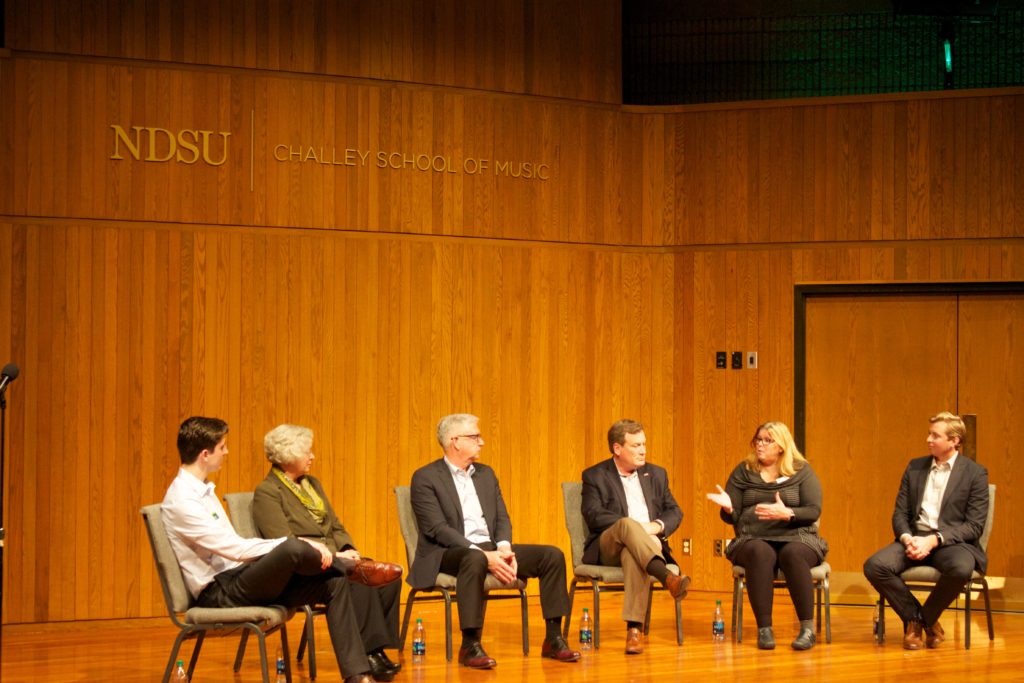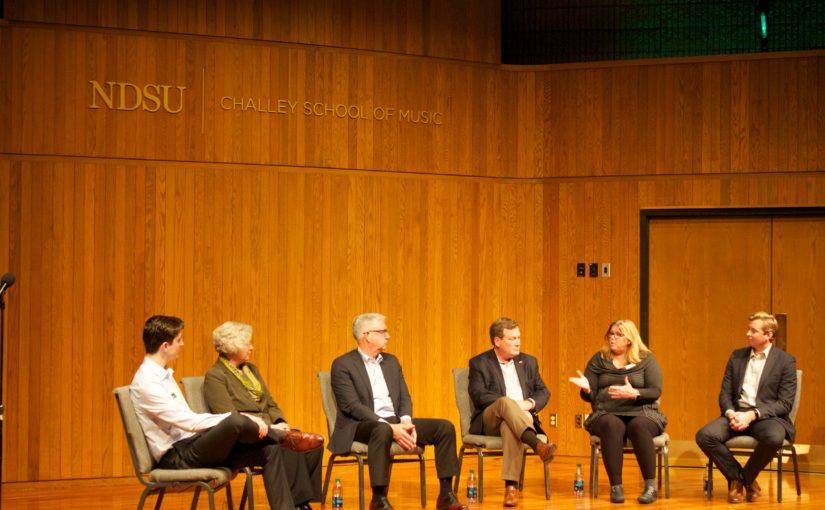
The speakers addressed issues in the FM community.
Five leaders from the Fargo-Moorhead community gathered to discuss the cultural growth of the area as well as the differences and similarities between the two cities. The North Dakota State Honors Program sponsored the speaker series, called “What the River Divides,” and it took place in the Beckwith Recital Hall Thursday, Nov. 1.
Among the speakers were Tony Grindberg, a commissioner in the city of Fargo; Pastor Sue Koesterman, executive director of Churches United for the Homeless; Derrick LaPoint, chief executive officer for Downtown Moorhead Inc.; Mark Nisbet, a board chair for the Fargo Moorhead West Fargo Chamber of Commerce; and Charlene Wolf-Hall, vice provost of Academic Affairs at NDSU. Each of these speakers discussed their own experience and knowledge of how Fargo and Moorhead are different and similar in economics, population growth and education.
The discussion started off with what each city does well that the other benefits from. The Tri-College system was mentioned because of the close proximity of NDSU, Minnesota State University Moorhead and Concordia College. Speakers noted that while each college holds their own unique culture, together these three colleges form an atmosphere through the values of education and work ethic that the community holds. LaPoint stated that all of these campuses aren’t isolated and are integrated into the community because of the transportation provided to students. Though many of the speakers said they believe that Minnesota has a better education system, they said the Tri-Colleges are what makes Fargo and Moorhead strengthen each other.
“Go out and explore.” – Pastor Sue Koesterman, executive director of Churches United for the Homeless
As the discussion progressed, deeper topics were brought up, such as affordable housing, the poverty rate and minorities in Fargo and Moorhead. Koesterman explained how 11 percent of minorities make up the population, but over half are in shelters. She described how important it is to provide minorities help while respecting their cultures. LaPoint mentioned a diversity job fair that was held in Moorhead that gave minorities the chance to find employment and make a presence in the community. He also talked about all of the family-owned businesses that make our region unique because of the diversity that comes with them.
All of the speakers agreed that housing is too expensive for the incomes being earned. Koesterman explained how a lot of the people in the shelters are working more than one job, but still can’t afford to pay the rent of an apartment. According to Koesterman, the price of housing in Fargo and Moorhead is the same as housing in Minneapolis. She also talked about how a lot of children in the Fargo public schools are on free and reduced lunch and how there are many single-parent households in the area. Though Koesterman offered some solutions like the idea of lower-income housing being built, she noted that these ideas will take time to see what could work best. She also said she wants to see more work between the government and charity leaders to exactly pinpoint what both cities can improve upon.
If asked whether they live in one city and work in another, LaPoint pointed out that he lives in Fargo and works in Moorhead. For him, it’s just a matter of the job opportunity he was offered. He wouldn’t mind if he had to live in Moorhead or if he had a job in Fargo. Both Grindberg and Nisbet went to MSUM, but Grindberg said that North Dakota is his home and chooses to live and work here in Fargo. Most of the speakers wouldn’t mind where they would live and work, agreeing that both cities offer benefits.
The speakers said they believe the F-M area is what is known around the country when North Dakota is brought up. Grindberg said he remembered when North Dakota wasn’t well known in the Midwest and believes that with the progress that the F-M area has made, more people are coming here to find jobs. Grindberg also stated that more college students are staying within the F-M area after graduation while before college graduates were leaving to find employment elsewhere. The speakers agreed that as the government, business, charity and education leaders work together, the F-M area can improve even more in a way that will benefit the people.
As the discussion wrapped up, Koesterman suggested to “go out and explore.” She said she thinks that it’s important for everyone to discover all of what Fargo and Moorhead have to offer and to look at Fargo and Moorhead without a river dividing us.
